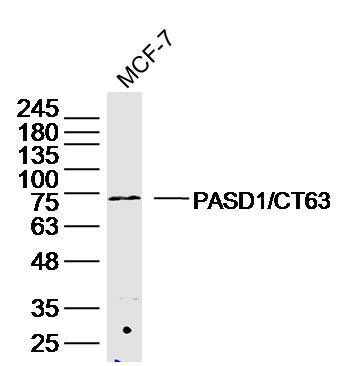PASD1/CT63 Polyclonal Antibody
Purified Rabbit Polyclonal Antibody (Pab)
- SPECIFICATION
- CITATIONS
- PROTOCOLS
- BACKGROUND

Application
| WB, IHC-P, IHC-F, IF, ICC, E |
|---|---|
| Primary Accession | Q8IV76 |
| Host | Rabbit |
| Clonality | Polyclonal |
| Calculated MW | 70 KDa |
| Physical State | Liquid |
| Immunogen | KLH conjugated synthetic peptide derived from human PASD1/CT63 |
| Epitope Specificity | 1-100/773 |
| Isotype | IgG |
| Purity | affinity purified by Protein A |
| Buffer | 0.01M TBS (pH7.4) with 1% BSA, 0.02% Proclin300 and 50% Glycerol. |
| SUBCELLULAR LOCATION | Nucleus. |
| SIMILARITY | Contains 1 PAS (PER-ARNT-SIM) domain. |
| Important Note | This product as supplied is intended for research use only, not for use in human, therapeutic or diagnostic applications. |
| Background Descriptions | This gene encodes a protein that is thought to function as a transcription factor. The protein is a cancer-associated antigen that can stimulate autologous T-cell responses, and it is therefore considered to be a potential immunotherapeutic target for the treatment of various hematopoietic malignancies, including diffuse large B-cell lymphoma. [provided by RefSeq, May 2010] |
| Gene ID | 139135 |
|---|---|
| Other Names | Circadian clock protein PASD1, Cancer/testis antigen 63, CT63, OX-TES-1, PAS domain-containing protein 1 {ECO:0000303|PubMed:15162151, ECO:0000312|HGNC:HGNC:20686}, PASD1 (HGNC:20686) |
| Target/Specificity | Testis-specific. Found in histologically normal tissues from patients with uterus, lung and small intestine cancers. Widespread expression seen in solid tumors and diffuse large B-cell lymphoma (DLBCL)-derived cell lines. Isoform 2 is expressed in all DLBCL-derived cell lines, while isoform 1 is preferentially expressed in cell lines derived from non-germinal center DLBCL. |
| Dilution | WB=1:500-2000,IHC-P=1:100-500,IHC-F=1:100-500,ICC=1:100-500,IF=1:100-500,ELISA=1:5000-10000 |
| Storage | Store at -20 ℃ for one year. Avoid repeated freeze/thaw cycles. When reconstituted in sterile pH 7.4 0.01M PBS or diluent of antibody the antibody is stable for at least two weeks at 2-4 ℃. |
| Name | PASD1 (HGNC:20686) |
|---|---|
| Function | Functions as a suppressor of the biological clock that drives the daily circadian rhythms of cells throughout the body (PubMed:25936801). Acts as a nuclear repressor of the CLOCK-BMAL1 heterodimer-mediated transcriptional activation of the core clock components (PubMed:25936801). Inhibits circadian clock function in cancer cells, when overexpressed (PubMed:25936801). |
| Cellular Location | [Isoform 1]: Nucleus. Note=Associates preferentially at the periphery of the nucleus with heterochromatin (PubMed:25936801) |
| Tissue Location | Testis-specific (PubMed:25936801). Expressed in a broad range of cancer cells, including melanoma, lung cancer, and breast cancer (at protein level). Testis-specific (PubMed:15162151) Found in histologically normal tissues from patients with uterus, lung and small intestine cancers. Widespread expression seen in solid tumors and diffuse large B-cell lymphoma (DLBCL)-derived cell lines. Isoform 2 is expressed in all DLBCL-derived cell lines, while isoform 1 is preferentially expressed in cell lines derived from non-germinal center DLBCL (PubMed:15162151). |

Thousands of laboratories across the world have published research that depended on the performance of antibodies from Abcepta to advance their research. Check out links to articles that cite our products in major peer-reviewed journals, organized by research category.
info@abcepta.com, and receive a free "I Love Antibodies" mug.
Provided below are standard protocols that you may find useful for product applications.
If you have used an Abcepta product and would like to share how it has performed, please click on the "Submit Review" button and provide the requested information. Our staff will examine and post your review and contact you if needed.
If you have any additional inquiries please email technical services at tech@abcepta.com.













 Foundational characteristics of cancer include proliferation, angiogenesis, migration, evasion of apoptosis, and cellular immortality. Find key markers for these cellular processes and antibodies to detect them.
Foundational characteristics of cancer include proliferation, angiogenesis, migration, evasion of apoptosis, and cellular immortality. Find key markers for these cellular processes and antibodies to detect them. The SUMOplot™ Analysis Program predicts and scores sumoylation sites in your protein. SUMOylation is a post-translational modification involved in various cellular processes, such as nuclear-cytosolic transport, transcriptional regulation, apoptosis, protein stability, response to stress, and progression through the cell cycle.
The SUMOplot™ Analysis Program predicts and scores sumoylation sites in your protein. SUMOylation is a post-translational modification involved in various cellular processes, such as nuclear-cytosolic transport, transcriptional regulation, apoptosis, protein stability, response to stress, and progression through the cell cycle. The Autophagy Receptor Motif Plotter predicts and scores autophagy receptor binding sites in your protein. Identifying proteins connected to this pathway is critical to understanding the role of autophagy in physiological as well as pathological processes such as development, differentiation, neurodegenerative diseases, stress, infection, and cancer.
The Autophagy Receptor Motif Plotter predicts and scores autophagy receptor binding sites in your protein. Identifying proteins connected to this pathway is critical to understanding the role of autophagy in physiological as well as pathological processes such as development, differentiation, neurodegenerative diseases, stress, infection, and cancer.


